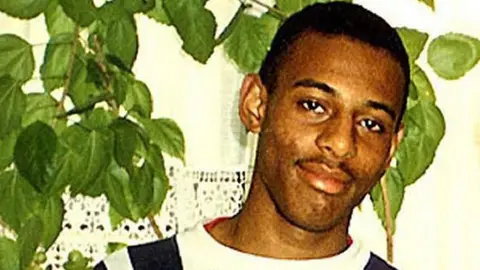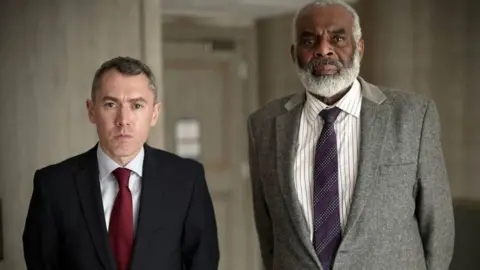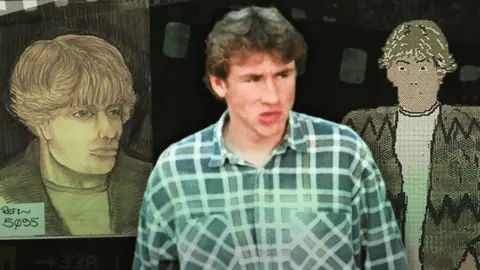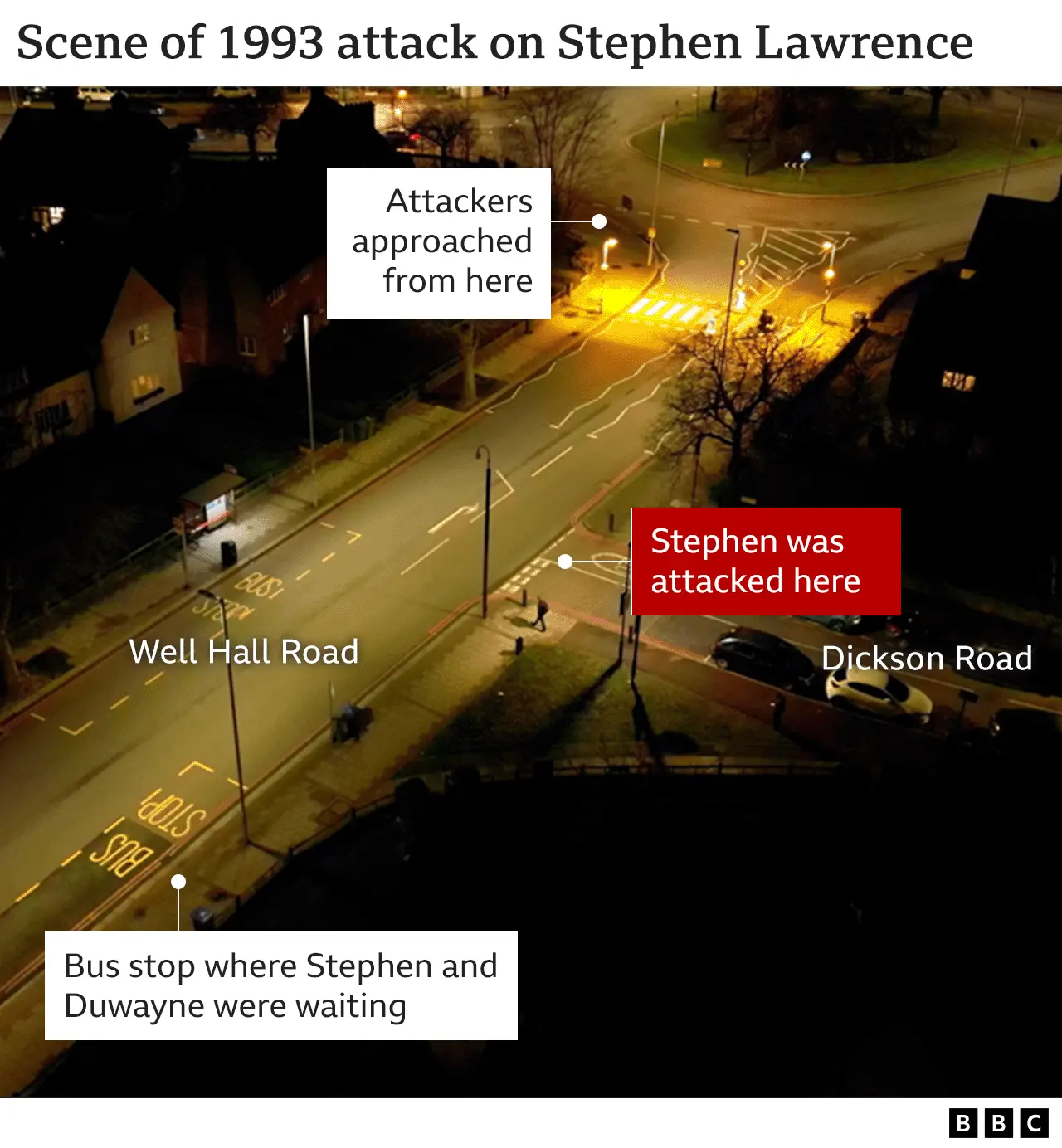Stephen Lawrence murder: How I found the new suspect 30 years on
 Family Handout
Family HandoutEarlier this week, the BBC publicly named a major suspect in the Stephen Lawrence murder. In response, Stephen's mother Baroness Doreen Lawrence said, "It should not have taken a journalist to do the job that a huge, highly resourced institution should have done." Correspondent Daniel De Simone started investigating the case after the Metropolitan Police stopped.
Investigating the murder of Stephen Lawrence is a journey into the past and the present.
Stephen was murdered 30 years ago in a racist attack by a gang of young white men.
Two years ago, I set out to follow a lead which had the potential to bring significant new information to light.
The Met had stopped investigating Stephen's murder in 2020. I wanted to do what I could to investigate the outstanding suspects and hold them to account.
I had no previous experience of covering the case and I felt daunted by it. Journalists had been covering the story since the 1990s, and there had been more than 15 police investigations or official inquiries. Who was I to imagine I could find anything new?

The lead I followed related to a man who was said to have possibly been there when Stephen was murdered. I was unsure whether this was as a witness or a suspect. I did not know the man's identity, and it took months to get a name. In the meantime, I read everything I could about Stephen's case.
When I got a name, I realised the man - Matthew White - was the person in the case known as Witness K.
I had read a lot about Witness K. His claimed role did not involve being present during the attack, but instead acting as a central link in a chain of how information was passed around on the night of the murder.
This chain was said to have included a brief visit by K to the home of suspects Neil and Jamie Acourt.
White died in 2021, aged 50, around the time I started investigating, meaning I was unable to approach him.
A constant source of help and advice was Clive Driscoll, the retired Met detective who had brought two of Stephen's killers to justice. He told me that following the two murder convictions he achieved in 2012, he had focused on the other killers.
One of those he investigated was Matthew White, and Clive told an extraordinary tale of finding that an approach by one of White's stepfathers had been disastrously mishandled by the Met in 1993.
Clive had arrested White in late 2013, after personally tracing the right stepfather, who said White had admitted being present during the murder. But Clive had been unable to complete his investigation after Scotland Yard replaced him as senior investigating officer and he was asked to retire.
I felt silly even thinking it, but I was trying to conduct my own murder investigation.

The complexity of Stephen's case has increased with time - and the number of investigations and inquiries have only added to the already large volume of information.
I had to try to get across three decades of evidence, much of it hidden in police files. I gained access to previously secret documents about the case and read every transcript from the 1998 Macpherson public inquiry into the murder. Several people helped me confidentially, providing crucial information during the process of checking and corroboration.
It became clear there was a gaping hole in the case.
On the night of the murder, Stephen's friend Duwayne Brooks had said there were six attackers, and gave a description of a fair-haired attacker who did not fit the profile of the five well-known prime suspects. Eyewitnesses to the murder had described the same person. Who was he? Why did everyone seem to have forgotten about this key point?
In addition, Matthew White had been referred to many times in the case. I found Kent Police had told the Met in 1997 to get to the bottom of his role, and had raised the prospect of him being present during the attack. The issue had been raised during the Macpherson inquiry hearings the following year.
In 2000, I discovered a witness had told the Met about White confessing to being present during the attack and playing a leading role in it. This witness had spoken to police independently of White's stepfather, who Clive Driscoll tracked down. Checked against the evidence of Duwayne Brooks and eyewitnesses, the account of White's confession was compelling.
It was clear that White was a suspect and that police had eventually treated him as one. How fair was this designation? Was he the sixth man?
I sought to crosscheck everything else I was finding on White against other evidence, including witness accounts from 1993. White surely had an alibi for the night, given that he was known as Witness K and appeared so prominently in narratives of the case?
The failure of the first police investigation had polluted all later attempts to gather evidence and get to the truth. I found the same thing.
It was therefore surprising that, despite everyone accepting the first investigation had been a disaster, there was still a reliance on many statements gathered by it. I was particularly distrustful of anything gathered by a particular detective.
I did not want to take anything from 1993 at face value, so - where possible - I spoke to witnesses from the time myself. I spent weeks in Eltham, south-east London, and travelled all around the country finding people. Many witnesses remain reluctant to help, and I was frequently told to get lost.

I built a timeline of the night of the murder and the days following it. I also listed and investigated all possible case theories relating to White: these included various ways in which he could have played a part in the group that attacked Stephen, and various ways in which he could, instead, have been a witness.
The complexity of the scene that night in April 1993 meant I particularly wanted to check if White had somehow been an eyewitness to the attack or its aftermath - or had spoken to an eyewitness or attacker within moments of the murder.
There were people seen near the crime scene in the minutes before the attack who are not accounted for.
The sightings - on a roundabout in sight of where Stephen was stabbed - were by witnesses passing through the area.
One of those seen in the area could have been White, so I did what I could to check this possibility.
On the night of the attack, there was another group of young men near the scene. When spoken to by police, this group accepted being nearby, but generally denied going onto the roundabout. When I spoke to members of the group, they denied seeing White that evening.
When I spoke to another witness who had passed through the scene just before the attack, that person also denied seeing White.
I found nothing to support a case theory that White had been a bystander on the roundabout.
Over time, the least likely case theory of all came to be the "Witness K" one accepted by police in 1993. When I checked White's alibi, I found it did not exist. He had lied.
I also found that a witness had given a false account relating to White, which had allowed him to claim that he first heard about the stabbing from a local girl who had passed by the crime scene in the aftermath.
From my own research, it was apparent the Met had not checked his alibi for at least 15 years, despite sending a file to prosecutors after Clive Driscoll was prevented from completing his investigation.
The fact that a false account was told was a crucial discovery. Who else was not telling the full truth?

New evidence about the murder of Stephen Lawrence, uncovered by BBC investigative reporter, Daniel De Simone.

I sought to consider all evidence that undermined the possibility of White being present during the attack. There were reasons to doubt he would have behaved in some of the ways he apparently did - if he had been present - including visiting the scene after the attack and telling other people who was responsible for the murder.
But his stepfather said he had behaved like the murder had been an "everyday occurrence".
I also kept finding that people were sympathetic to White, in a way they were not towards suspects Neil and Jamie Acourt - or to David Norris, who was convicted of murdering Stephen in 2012.
The same thing kept happening in relation to Gary Dobson - the other man jailed in 2012 - with various people casting doubt on his conviction and saying he was a nice bloke. If people kept saying that about the racist drug-dealing murderer Gary Dobson, was it a surprise there was sympathy for White?
I also kept being told false and malicious rumours about Stephen Lawrence.
I realised what I was encountering was deep-seated racism that dehumanised Stephen. Some people clearly did not care about the victim. Racism had killed Stephen, and it was blocking the truth from being told.
White himself was plainly the source of some of the rumours. Two people with very close links to him made the same false claims to me, independently of one another. I shall not repeat the lies, but they showed that White was telling lies about Stephen to justify what happened to him.
This was deeply ironic given that White was a violent drug-using thief - a total contrast to Stephen.
In the end, it was clear to me that White was indeed a major suspect in the murder. The BBC decided to identify him as such, and Scotland Yard's highly unusual response was to name him as a suspect and apologise for its handling of the case.
The evidence relating to White points towards, not away from, outstanding suspects in the case.
Will there ever be full justice for Stephen Lawrence?

If you have information about this story that you would like to share with BBC News' Stephen Lawrence investigation please get in touch. Email [email protected].
Please include a contact number if you are willing to speak to a BBC journalist. You can also get in touch in the following ways:
- WhatsApp: +44 7756 165803
- Tweet: @BBC_HaveYourSay
- Upload pictures or video
- Please read our terms & conditions and privacy policy
You can also get in touch using SecureDrop, a highly anonymous and secure way of whistleblowing to the BBC which uses the TOR network.
- SecureDrop: http://kt2bqe753wj6dgarak2ryj4d6a5tccrivbvod5ab3uxhug5fi624vsqd.onion/
Please note that the SecureDrop link will only work in a Tor browser. For information on keeping secure and anonymous, here's some advice on how to use SecureDrop.
If you are reading this page and can't see the form you will need to visit the mobile version of the BBC website to submit your question or comment or you can email us at [email protected]. Please include your name, age and location with any submission.
